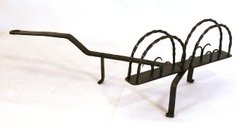Tools for Toasting, Roasting, Frying and Baking
A well-stocked kitchen, full of tools suited to a variety of food preparation and measuring methods, was a sign of an affluent household. New World noblemen or plantation owners often had trained European cooks and lavish kitchens with state-of-the art tools and cooking implements. At the Governor's Palace in Colonial Williamsburg, "the household inventory for Governor Botetourt listed copper pots, a spit jack, and an eight-day clock" (The Colonial Williamsburg Foundation, 2012, para. 3). Similarly, at Thomas Jefferson's Monticello, the kitchen included "an eight-hole stew stove as well as a set kettle, another built-in convenience which provided constant hot water. At the hearth is a clockwork spit-jack for roasting meats. And arrayed on the dresser are gleaming copper saucepans and fish kettles, representing the over sixty pieces of copper cookware that Jefferson had shipped back from France in 1790" (Thomas Jefferson Foundation, 2003, para. 3).
In stark contrast to the convenience and choice afforded to the upper classes, those of more modest means prepared basic meals, often using just a few tools. According to Kalman & Brown (2002), "pots and pans were expensive. Some cooks owned several, but many did all their cooking in one or two pots" (p. 8). "The poor were very limited in cooking equipment, often having only one cast iron pot. The wife of the house prepared basic soups and grain porridges" (The Colonial Williamsburg Foundation, 2012, para. 6).
In stark contrast to the convenience and choice afforded to the upper classes, those of more modest means prepared basic meals, often using just a few tools. According to Kalman & Brown (2002), "pots and pans were expensive. Some cooks owned several, but many did all their cooking in one or two pots" (p. 8). "The poor were very limited in cooking equipment, often having only one cast iron pot. The wife of the house prepared basic soups and grain porridges" (The Colonial Williamsburg Foundation, 2012, para. 6).
Brass KettleAn essential tool found in every Colonial kitchen, the heavy brass kettle was a prized possession, "weighing about 40 pounds (18 kilograms) and holding up to 15 gallons (57 liters) of liquid. Besides being used to cook soups or stews, this vast pot was used for other chores, such as boiling laundry on wash day" (Ichord, 1998, p. 11).
Dutch OvenThe Dutch oven served as a fireplace baker, and was usually placed over hot coals away from the open flame. The Colonial cook "then scooped hot coals on top of the lid as well so the food would cook evenly on all sides. The cook baked hams, casseroles, and cakes in the Dutch oven" (Kalman & Brown, 2002, p. 8).
SpiderThis fireside frying skillet was "called a spider because it was a three-legged black skillet, resembling the web spinner" (Ichord, 1998, p. 11). The legs allowed it to sit over the hot coals, and it had a long handle which "allowed the cook to move the pan without putting her hands near the fire" (Kalman & Brown, 2002, p. 8).
|
Tin Kitchen and Other Roasting Tools

A tin kitchen at Old Salem.
This fireside roaster was used to cook meat, which was mounted on a spit in the center of the device. A drip pan was situated on the bottom to catch grease as the meat cooked. A hand crank was attached to the spit on the outside of the assembly, so a cook could turn it without getting burned. The open part of the tin kitchen faced the flame, and the curved part kept the heat centered on the meat for faster cooking. A small door was located at the top of the curved portion, making it easy for the cook to check and baste the meat.
Other kitchens made use of the clock jack, a wind-up device that hung over the fire. Meat was attached to a hook on the bottom of the jack, and "as the minutes ticked by, the jack turned the roast slowly and cooked it on all sides" (Kalman & Brown, 2002, p. 9).
Meat could also be roasted without either of these, by simply putting it on a spit and "supporting it in front of the fire with two forked uprights, called andirons or firedogs. A drip pan was placed underneath to catch the juices for gravy" (Ichord, 1998, p. 8).
Other kitchens made use of the clock jack, a wind-up device that hung over the fire. Meat was attached to a hook on the bottom of the jack, and "as the minutes ticked by, the jack turned the roast slowly and cooked it on all sides" (Kalman & Brown, 2002, p. 9).
Meat could also be roasted without either of these, by simply putting it on a spit and "supporting it in front of the fire with two forked uprights, called andirons or firedogs. A drip pan was placed underneath to catch the juices for gravy" (Ichord, 1998, p. 8).
Toaster

This wrought iron toaster could toast two slices of bread at a time, one on each curved section, making it a useful tool for an early American cook. "When one side of the toast was done, she turned the bread to toast the other side" (Kalman & Brown, 2002, p. 9). The example shown at right features a swivel mechanism, so that the bread doesn't have to be removed from the toaster in order to toast both sides of the bread.
Title photo: A group of assorted jugs, cutting boards and other kitchen tools at Old Salem in Winston-Salem, NC. Taken in March 2012 by Brooks Jones.

